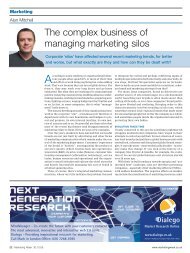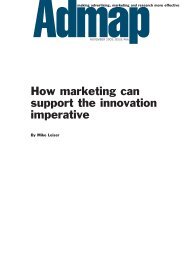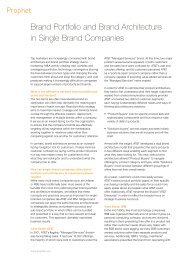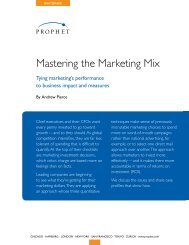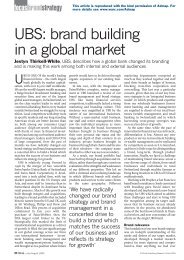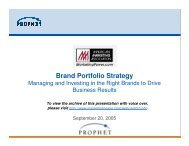Download the PDF - Prophet
Download the PDF - Prophet
Download the PDF - Prophet
Create successful ePaper yourself
Turn your PDF publications into a flip-book with our unique Google optimized e-Paper software.
Warc Exclusive<br />
April 2010<br />
Escaping <strong>the</strong> Black Hole of Sponsorships<br />
Chiaki Nishino and Fred Geyer<br />
<strong>Prophet</strong><br />
Even in a struggling economy, sponsorships – particularly those involving sports – command a significant proportion of big businesses'<br />
marketing mix.<br />
After declining for <strong>the</strong> first time (by 0.6 percent to $16.51 billion) in 2009, sponsorship spending by North American companies is expected<br />
to grow 3.4% to $17.08 billion this year, according to <strong>the</strong> IEG Sponsorship Report. European companies are expected to boost spending by<br />
5 percent to $12.7 billion, while worldwide sponsorship is expected to grow 4.5 percent to $46 billion.<br />
Difficult times only increase <strong>the</strong> pressure to manage marketing more effectively, with an eye toward enhanced accountability. But<br />
sponsorships remain an important marketing investment that, on <strong>the</strong> whole, defies effective management.<br />
Many struggle to manage multi-year commitments that were locked in when sales and marketing budgets were flush. And <strong>the</strong>n, <strong>the</strong>re are<br />
<strong>the</strong> image issues, compounded by circumstances of <strong>the</strong> 2008-2009 economic meltdown. Bank of America ended discussions with <strong>the</strong> New<br />
York Yankees for fear of consumer backlash. Royal Bank of Scotland raised eyebrows by extending its sponsorship of <strong>the</strong> Six Nations'<br />
rugby tournament just before announcing $41 billion in losses. Switzerland's second-largest bank UBS cancelled its sponsorship of <strong>the</strong> Hong<br />
Kong Open golf tournament after last November's event. The bank received a $59.2 billion bailout from <strong>the</strong> Swiss government following <strong>the</strong><br />
global financial crisis.<br />
Here's how sponsorship black holes are created. A Performance Research and IEG study found that 43% of companies spend nothing on<br />
primary customer research to evaluate <strong>the</strong> fit of <strong>the</strong>ir sponsorships. Fur<strong>the</strong>r, <strong>the</strong>y're more likely to ask what competitors are sponsoring<br />
than to investigate <strong>the</strong> sponsorship's appeal to <strong>the</strong>ir own customers.<br />
© 2010 IEG, LLC. Sponsorship report<br />
www.warc.com<br />
And that's on <strong>the</strong> front end. On <strong>the</strong> back is a lack of metrics to evaluate sponsorships' impact. The Performance Research/IEG study also<br />
showed that 40 percent of sponsors spend less than 1 percent of <strong>the</strong>ir sponsorship fees on all of <strong>the</strong>ir sponsorship metrics; 36 percent<br />
spend nothing at all.
© 2010 IEG, LLC. Sponsorship report<br />
To an extent, that's understandable, given three major factors that characterise most sponsorships.<br />
● Their confidential, deal-by-deal nature has made it difficult to assemble standard market metrics. Benchmarks such as reach,<br />
frequency, audience composition and cost (CPM) that are standard for o<strong>the</strong>r paid media advertising cannot be obtained through<br />
syndicated sources for sponsorships.<br />
● Sponsorships can have very different objectives, ranging from driving awareness to creating customer loyalty to improving<br />
corporate reputation. And companies often have multiple objectives.<br />
● Many sponsorships utilise a wide variety of marketing vehicles and tactics that increase <strong>the</strong> complexity of measurement. For<br />
example, Holiday Inn's sponsorship with Major League Baseball includes tickets for staying at a hotel, utilizing loyalty points for VIP<br />
experiences at All Star games, a live attraction at <strong>the</strong> FanFest associated with <strong>the</strong> All Star game, and more traditional billboards and<br />
television media.<br />
It's also important to note that desired outcomes will change over time, and <strong>the</strong> measures used to evaluate success/impact should shift<br />
accordingly. Before ending <strong>the</strong> relationship in 2009 due to his well-publicised marital infidelities, Accenture's sponsorship with <strong>the</strong> Tiger<br />
Woods underwent just <strong>the</strong>se kinds of changes. From 2003-2006, for example, <strong>the</strong> sponsorship was focused on shifting Accenture's brand<br />
image from innovation to performance. Starting in 2006, however, it was more focused on using Tiger Woods to help convey high<br />
performance, successfully having changed its image in <strong>the</strong> previous years.<br />
With all <strong>the</strong>se considerations that must be factored into <strong>the</strong>ir sponsorship arrangements, it's a small wonder that <strong>the</strong>y've become a black<br />
hole of marketing for many businesses. But marketers can escape it, and improve both <strong>the</strong> sponsorships <strong>the</strong>mselves and <strong>the</strong>ir investments<br />
in different parts of <strong>the</strong> portfolio of sponsorship properties. They start by tackling three sets of issues; Strategy, Selection, and Support.<br />
Strategy: Establishing <strong>the</strong> sponsorship strategy and <strong>the</strong> optimal portfolio of sponsorship properties is a crucial first step that's often<br />
overlooked. What objectives can be met through sponsorships? What role should sponsorships play in <strong>the</strong> overall marketing strategy?<br />
Sponsorship strategy is all about getting <strong>the</strong> basics right such as identifying <strong>the</strong> targets to influence via a sponsorship, defining <strong>the</strong> attitudes<br />
and behaviours sponsorships should change and thinking through whe<strong>the</strong>r and how sponsorships will link to o<strong>the</strong>r marketing and sales<br />
programmes. Once <strong>the</strong> basics are in place <strong>the</strong> strategy has to identify <strong>the</strong> components in <strong>the</strong> portfolio of properties. Several questions<br />
should be addressed:<br />
● Is it best to focus on one or two properties or support a range?<br />
● Do we need to cover a full year or spike in a key selling period?<br />
● Are separate properties needed for different target segments?<br />
● Should a central <strong>the</strong>me linked to <strong>the</strong> brand underlie our sponsorships?<br />
● What are <strong>the</strong> no-go types of sponsorship, why are <strong>the</strong>y off base?<br />
Selection: Most would agree that identifying, evaluating, and selecting high-impact sponsorship opportunities is important. However, it's<br />
surprising how many companies fixate on sponsorships promoted by influential internal champions and fail to examine <strong>the</strong> full range of<br />
potential sponsorships. What opportunities are <strong>the</strong> most and least attractive? What are <strong>the</strong> roles individual sponsorships will play in a<br />
portfolio of <strong>the</strong>m?<br />
The key to selecting <strong>the</strong> right sponsorship is to be very clear about how it fits with your objectives and plans for a brand instead of thinking<br />
how <strong>the</strong> brand can fit to <strong>the</strong> sponsorship. Key criteria for evaluating sponsorship choices can be prioritised:<br />
1. Brand fit – fits <strong>the</strong> target and fits <strong>the</strong> brand personality.<br />
2. Impact – how well known, how well regarded, how unique?<br />
3. Uniqueness – can you identify clear ways to associate your brand closely with <strong>the</strong> sponsorship without being lost in a crowd of o<strong>the</strong>r<br />
sponsors?<br />
4. Risk – what's <strong>the</strong> potential for <strong>the</strong> property to sour? How damaging could this be to your brand?<br />
5. Return – is <strong>the</strong>re a clear, measurable path to delivering <strong>the</strong> attitude and behavioural changes among consumers that must occur to<br />
make money?
Support: Each sponsorship must be optimally structured to achieve <strong>the</strong> objectives defined during strategy and selection. What advertising,<br />
promotional, and customer engagement programmes deliver <strong>the</strong> most exposure to and extract <strong>the</strong> most value from different sponsorships?<br />
What are <strong>the</strong> best levels of investment for each property and programme?<br />
The key to optimising investment is to categorise sponsorships in <strong>the</strong> portfolio based on <strong>the</strong>ir roles and objectives and use it as a guide for<br />
investment levels. The pitfall that many sponsors succumb to is increasing investment in successful, but niche sponsorships over time. This<br />
scope creep can turn a great event intended for <strong>the</strong> trade into a larger, but perhaps unsuitable, consumer event.<br />
From <strong>the</strong>re, a measurement process must be put into place. One way to go is a three-part process that measures sales response, brand<br />
equity impact, and contribution to marketing efficiency.<br />
● Sales response measurement typically involves combining purchase and investment data through marketing mix modelling or<br />
historical analysis. Coca-Cola, for example, uses this to distinguish between <strong>the</strong> volume generated at <strong>the</strong> event itself, through local<br />
market promotion and through national advertising and promotion.<br />
● Assessing brand equity impact requires identifying <strong>the</strong> customer attitudes that drive value-creating behaviours. Measuring <strong>the</strong> extent<br />
of changes before and after <strong>the</strong> sponsorship shows whe<strong>the</strong>r <strong>the</strong> programme is really enhancing brand equity. This type of analysis<br />
can be extremely valuable whenever brand objectives are crucial to success, such as Citibank's commitment to <strong>the</strong> new Mets'<br />
ballpark, Citifield.<br />
● Contribution to marketing efficiency is also important. Take local marketing activities of individual bars and restaurants on behalf of<br />
leading brewers for events such as <strong>the</strong> World Cup or <strong>the</strong> Super Bowl. Their micro-marketing clout obviously eliminates costs that<br />
<strong>the</strong> brewer would have to shoulder. But brewers continuously partner with local bars and restaurants. The trick to efficiency analysis<br />
is comparing <strong>the</strong> efficiency gains from using a particular sponsorship to o<strong>the</strong>r sponsorships and o<strong>the</strong>r local marketing programmes.<br />
Where to start? Introduce a few simple metrics that can rapidly improve sponsorship investment decision-making. From <strong>the</strong>re, <strong>the</strong> pace of<br />
improvement can be accelerated over time by making processes more robust, expanding data collection, and enhancing analytical skills.<br />
The ultimate goal is to be able to combine historical analysis of individual aspects of <strong>the</strong> sponsorship programme with test and learn<br />
experiments that assess <strong>the</strong> aspects of <strong>the</strong> sponsorship programme that are hard to measure discretely using historical analysis.<br />
The roiling economy has put pressure on businesses to ensure that <strong>the</strong>ir sponsorship commitments deliver, and it may actually be a<br />
positive development. It's an incentive for <strong>the</strong>m to face up to <strong>the</strong> fact that sponsorship marketing can and must be better measured and<br />
managed. Sponsorships can be effective and powerful. But <strong>the</strong> question that those who invest in sponsorship marketing must face is<br />
whe<strong>the</strong>r <strong>the</strong>ir strategies, property portfolio, and programmes are effective and generating strong returns in good times and in bad.<br />
About <strong>the</strong> authors<br />
Chiaki Nishino and Fred Geyer are partners of <strong>Prophet</strong> (www.prophet.com), a strategic brand and<br />
marketing consultancy that helps clients win by delivering inspired and actionable ideas.<br />
Contact <strong>the</strong>m at cnishino@prophet.com and fgeyer@prophet.com.<br />
© Copyright Warc 2010<br />
Warc Ltd.<br />
85 Newman Street, London, United Kingdom, W1T 3EX<br />
Tel: +44 (0)20 7467 8100, Fax: +(0)20 7467 8101<br />
All rights reserved including database rights. This electronic file is for <strong>the</strong> personal use of authorised users based at <strong>the</strong> subscribing<br />
company's office location. It may not be reproduced, posted on intranets, extranets or <strong>the</strong> internet, e-mailed, archived or shared<br />
electronically ei<strong>the</strong>r within <strong>the</strong> purchaser’s organisation or externally without express written permission from Warc.<br />
www.warc.com



